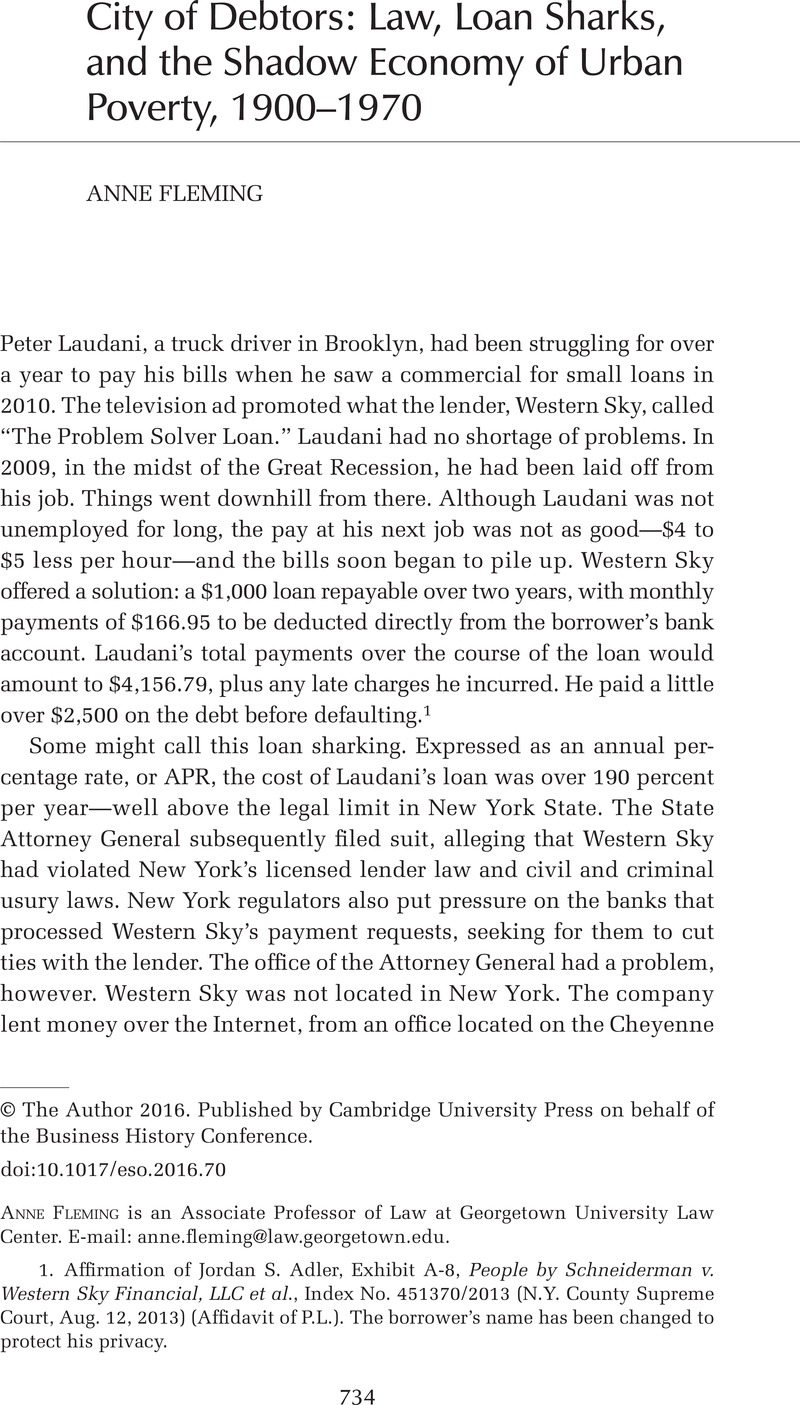Published online by Cambridge University Press: 14 November 2016

1. Affirmation of Jordan S. Adler, Exhibit A-8, People by Schneiderman v. Western Sky Financial, LLC et al., Index No. 451370/2013 (N.Y. County Supreme Court, Aug. 12, 2013) (Affidavit of P.L.). The borrower’s name has been changed to protect his privacy.
2. Respondents’ Memorandum of Law in Support of their Motion to Dismiss, People by Schneiderman v. Western Sky Financial, LLC et al., Index No. 451370/2013 (N.Y. County Supreme Court, Sept. 17, 2013); Respondents’ Memorandum of Law in Opposition to Respondents’ Motion to Dismiss and in Further Support of the Verified Petition, People by Schneiderman v. Western Sky Financial, LLC et al., Index No. 451370/2013 (N.Y. County Supreme Court, Oct. 25, 2013).
3. Andrew R. Johnson, “Payday Lender Agrees to Fine, Refunds,” Wall Street Journal, January 23, 2014.
4. On small-sum lending between the Progressive Era and Great Depression, see Lendol Glen Calder, Financing the American Dream: A Cultural History of Consumer Credit (Princeton, NJ: Princeton University Press, 1999); Mark H. Haller and John V. Alviti, “Loansharking in American Cities: Historical Analysis of a Marginal Enterprise,” American Journal of Legal History 21 (1977): 125–156.
5. On the history of pawnshops, see Wendy A. Woloson, In Hock: Pawning in America from Independence through the Great Depression (Chicago: University of Chicago Press, 2010).
6. See Anne Fleming, “The Borrower’s Tale: A History of Poor Debtors in Lochner Era New York City,” Law and History Review 30, no. 4 (2012): 1053–1098.
7. Nassau County Department of Social Services, Legal Services for Welfare Clients: Three-Year Report as of April 30, 1970 (Mineola, NY, 1970), 12.
8. See, for example, Louis Hyman, Debtor Nation: The History of America in Red Ink (Princeton, NJ: Princeton University Press, 2011); Calder, Financing the American Dream.
9. See, for example, Greta R. Krippner, Capitalizing on Crisis: The Political Origins of the Rise of Finance (Cambridge, MA: Harvard University Press, 2011); Meg Jacobs, Pocketbook Politics: Economic Citizenship in Twentieth-Century America (Princeton, NJ: Princeton University Press, 2005); Ira Katznelson, When Affirmative Action Was White: An Untold History of Racial Inequality in Twentieth-Century America (New York: W. W. Norton, 2005); Alice Kessler-Harris, In Pursuit of Equity: Women, Men, and the Quest for Economic Citizenship in 20th-Century America (Oxford: Oxford University Press, 2001).
10. On the significance of state and local law in the governance of real estate and land use in the twentieth century, see, for example, N.D.B. Connolly, A World More Concrete: Real Estate and the Remaking of Jim Crow South Florida (Chicago: University of Chicago Press, 2014); Lizabeth Cohen, A Consumer’s Republic: The Politics of Mass Consumption in Postwar America (New York: Knopf, 2003).
11. See, for example, Jan L. Logemann, “From Cradle to Bankruptcy: Credit Access and the American Welfare State,” in The Development of Consumer Credit in Global Perspective: Business, Regulation, and Culture, edited by Jan L. Logemann, 201–219 (New York: Palgrave Macmillan, 2012); Krippner, Capitalizing on Crisis; Monica Prasad, The Land of Too Much: American Abundance and the Paradox of Poverty (Cambridge, MA: Harvard University Press, 2012); Gunnar Trumbull, Consumer Lending in France and America (Cambridge: Cambridge University Press, 2014), 10–12.
12. See, for example, Ann Carrns, “Subprime Borrowers Often Lured by High-Fee Credit Cards,” New York Times, February 5, 2015; Michael Corkery and Jessica Silver-Greenberg, “Many Buyers for Subprime Auto Loan Bundle,” New York Times, March 15, 2015.
13. See, for example, Editorial, “Progress on Payday Lending,” New York Times, March 28, 2015.